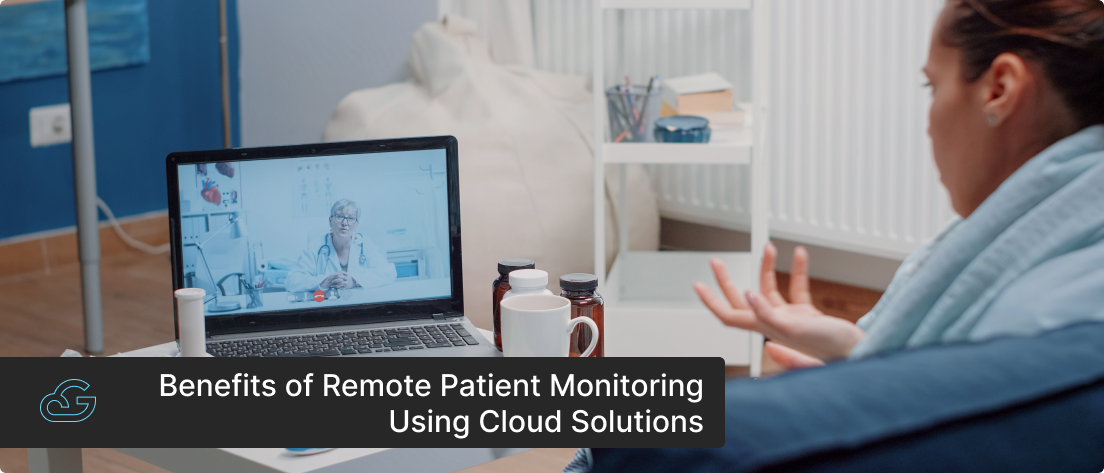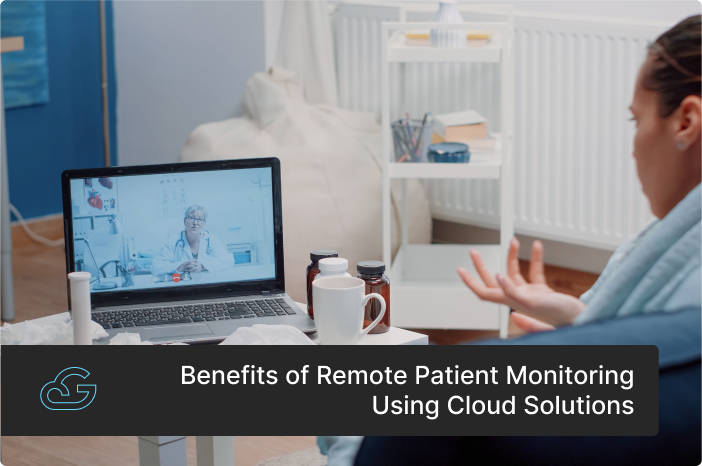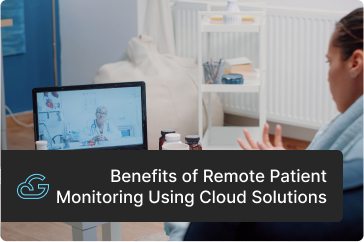Blogs / Cloud Consulting
Exploring the Benefits of Remote Patient Monitoring Using Cloud Solutions
By
Vineeth Babu
Posted: July 18, 2024
• 8 Minutes
The healthcare industry is undergoing a radical shift in the post-pandemic era. One of the most recent trends that has emerged is the increased adoption of virtual healthcare services and delivery systems. This includes remote patient monitoring (RPM)—a new-age approach that relies on digital devices to monitor patients outside the traditional clinical setting.
Remote patient monitoring has been gaining steady momentum in the last few years. According to market research firm Insider Intelligence, around 70 million patients in the US will start using RPM tools by 2025. This surge in adoption is largely driven by technological advancements, particularly cloud computing, which enables efficient data collection, storage, and analysis.
In this blog post, we will take a closer look at cloud-based remote patient monitoring while exploring the benefits and concerns around it. Let’s start by explaining what RPM is.
Understanding Remote Patient Monitoring
Remote patient monitoring is a telehealth approach that refers to the use of digital devices to monitor and capture a patient’s physiological data. The captured data is then transferred to healthcare providers like you through software applications or website platforms for further analysis. This enhances the overall patient experience while allowing you to make proactive clinical decisions.
Even though RPM has been around for a few years, the COVID-19 outbreak was a pivotal moment that enabled it to make a mark in the healthcare landscape. The pandemic exposed major shortcomings of the traditional healthcare systems, and RPM came out on top as a practical solution. Now, aided by technological advancements like IoT, Smart Wearables, Cloud Computing, AI, ML, etc., RPM is making a real push to disrupt and redefine modern-day healthcare delivery.
Here are certain trends that highlight the growing importance of RPM in today’s healthcare landscape.
- More healthcare organizations are coming forward and embracing remote patient monitoring while some are even extending their RPM program’s capabilities. For instance, a major healthcare organization in the US has transformed its remote patient monitoring program into a remote patient management program, which goes beyond monitoring to actively manage care remotely.
- The investment in RPM technology is rising, with many companies initiating innovations that enable “continuous monitoring”. Current RPM technology typically measures patient vitals at fixed intervals during certain times of the day. With continuous monitoring, healthcare professionals can constantly monitor body temperature, respiratory rate, pulse oximetry, heart rate, ECG, etc. This benefits high-acuity patients in cardiac care or hospital-at-home programs.
- The integration of predictive healthcare analytics and remote patient monitoring is accelerating. By combining the data collected by RPM systems and tools with AI and ML models, healthcare organizations can comprehensively analyze patient data, predict potential health issues, and provide personalized care recommendations. This enables proactive interventions and enhances patient outcomes.
So, that pretty much covers most of the general aspects of remote patient monitoring. By now, you will have a clear picture of what RPM is and its increasing importance in the healthcare sector. Now, let’s examine the role of cloud computing in driving this new healthcare delivery model in the next section.
What is Cloud-Based Remote Patient Monitoring?
A cloud-based remote patient monitoring system enables you to monitor patients remotely while harnessing the power of cloud computing. Using devices like fitness trackers, smartwatches, continuous glucose monitors, smart blood pressure cuffs, etc., this system collects physiological data from patients and transmits this data to cloud platforms for further analysis.
This process involves several stages:
- Data Collection: Patients use connected devices to measure various health parameters like heart rate, blood pressure, etc.
- Data Transmission: The device then transmits the collected data to the cloud securely.
- Data Storage: The cloud platform securely stores this data and makes it available to all authorized stakeholders 24/7.
- Data Analysis: The cloud provides powerful computing resources for conducting advanced analytics to process the data and identify health trends and potential issues.
- Alert System: After extensive analysis, the insights are transmitted back to the system, which alerts the healthcare providers if any concerning patterns are detected.
By leveraging the vast potential of cloud computing, you can design an RPM system that is highly scalable, responsive, and cost-effective. Let’s take a comprehensive look at the benefits of cloud-based RPM in the following sections.
Key Benefits of Cloud-Based RPM for Healthcare Providers
- Real-Time Tracking and Easy Access: Cloud-based RPMs come with the capability to process and store large volumes of healthcare data. With this instant access to up-to-date health data, you can proactively identify any symptom changes or emerging health issues. Additionally, the cloud’s accessibility means that you can monitor patients from any location, enabling swift responses to deteriorating conditions. This constant vigilance is crucial for managing chronic conditions or post-operative recovery.
- Predictive Analysis: A cloud-based RPM typically comes with advanced analytical capabilities that can be used for predictive analysis. By analyzing historical and real-time data, it can predict potential health declines. This capability enables you to intervene proactively and adjust treatment plans or medication dosages to prevent a patient’s health condition from worsening.
- Reduced Hospital Admissions: Cloud-based RPM systems can drastically reduce hospital admissions. By leveraging the scalability and high computational power of the cloud, you can simultaneously monitor numerous patients, identify those at the highest risk of hospitalization, and intervene proactively. This enhances healthcare delivery without the need for physical hospital admissions. As a result, you can effectively serve a larger patient population, improving healthcare accessibility and optimizing resource utilization.
- Improved Communication: The cloud enables secure messaging, video consultations, and real-time data sharing. This improved communication channel allows for timely interventions, quick answers to patient queries, and better overall care coordination. The cloud’s ability to integrate various communication tools into a single platform enhances the efficiency and effectiveness of patient-provider interactions.
- Lower Brick-And-Mortar Expenses: By leveraging cloud-based RPM, healthcare providers can reduce their reliance on physical infrastructure. The cloud eliminates the need for extensive on-premises data storage and processing capabilities, reducing costs associated with hardware, maintenance, and IT staff. Additionally, as more patient care can be managed remotely, there is less need for expansive physical facilities, further reducing operational costs.
Key Benefits of Cloud-Based RPM for Patients
- Enhanced Patient Experience: Cloud-based RPM systems enable your patients to receive medical attention from the comfort of their homes. This reduces the need for frequent in-person visits to the hospital. Furthermore, the cloud facilitates the integration of user-friendly interfaces and mobile apps, making it easy for your patients to engage with their health data. This increased engagement and comfort create an enhanced patient experience and result in better adherence to treatment plans.
- Minimal Disruption to Daily Lives: Cloud-based RPM predominantly relies on small-sized wearable devices and mobile apps connected to the cloud instead of bulky and stationary monitoring equipment. This non-intrusive, patient-centric approach results in minimal disruption to your patients’ daily lives, creating a sense of normalcy, especially for those managing chronic conditions.
- Customized Treatment Plans: Cloud-based RPM systems can analyze huge volumes of health data (lifestyle, medication response, symptom patterns, etc.) and identify patterns while churning out vital insights, which can help you create highly personalized treatment plans tailored to individual patient needs.
- Timely Intervention: Agility is one of the key highlights of cloud-based RPM systems. By leveraging the cloud’s real-time data processing and notification capabilities, they quickly detect any minor variations in the patient’s vitals while automatically alerting you. This high level of promptness ensures timely intervention, potentially saving lives.
- Cost-Effective Direct Care: By relying on cloud-based RPM, your patients can reduce their total medical expenses immensely. It minimizes frequent in-person visits to the clinic, thereby lowering transportation and admission costs. Additionally, with continuous monitoring and real-time data processing capabilities of RPM systems, you can detect potential health issues early, preventing the need for more costly invasive medical procedures.
Now that we have outlined some of the key benefits of cloud-based RPM, let’s analyze its practical applications across various healthcare scenarios. Let’s explore how this technology is making a difference in specific use cases.
How Does Cloud-Based RPM Help with Different Use Cases?
- Cardiovascular: Cloud-based RPM systems are extremely beneficial for patients who are at risk of cardiac arrest or undergoing cardiovascular care. These systems use wearable devices to capture data on the patient’s heart rate, blood pressure, etc. This data is then transmitted to the cloud for real-time analysis, which enables you to monitor trends over time, spot abnormalities, and intervene quickly if required.
- Diabetes: When it comes to diabetes or blood sugar management, cloud-based RPM systems leverage data from glucose monitors and insulin pumps. By processing this data, you can obtain crucial insights indicating whether the blood sugar level is dangerously high or low, allowing you to make adjustments in the treatment. In addition to this, you can also combine lifestyle data like diet and workout plans, facilitating more customized diabetes management.
- Chronic Obstructive Pulmonary Disease (COPD): For COPD, cloud-based RPM systems monitor vital signs such as respiratory rate, oxygen saturation, and lung function. The data is typically gathered using connected spirometers and pulse oximeters and transmitted to the cloud for detailed analysis. If there are any signs of exacerbations, the cloud platform will prompt you to intervene before the condition worsens. This is particularly important for patients suffering from mild COPD conditions, as the symptoms aren’t always apparent.
While these three use cases represent the versatility of cloud-based RPM, you must understand that it is only the tip of the iceberg. From pregnancy and bariatric care to postoperative and behavioral care, cloud-based RPM is extending its reach. Now, let’s look at some of the common concerns around it.
Potential Concerns Around Cloud-Based RPM
- Data Security Concerns: Healthcare data often includes sensitive information about a patient that he or she may not want to disclose to anyone else. And sharing this over a digital network that involves numerous data transmissions can be concerning for some of your patients. As healthcare service providers, it is up to you to address these concerns. For doing so, you must select the right cloud service provider that comes with built-in data security and privacy measures. Common cloud security mechanisms include role-based access controls, two-factor authentication, data encryption and decryption, endpoint security, and much more.
- Accuracy & Reliability Concerns: For cloud-based RPM, this is the elephant in the room. One of the main factors that has been a strong deterrent to technological foray into healthcare is patient safety. Traditionalists in the healthcare sector have long argued that the reliance on digital tools and cloud platforms could compromise patient safety. Typical concerns include the accuracy and reliability of healthcare data collected by remote devices and potential delays in transmitting critical health information. To mitigate these concerns, you must ensure that your cloud-based RPM system is properly tested and calibrated, complies with healthcare safety standards, and is continuously monitored and updated.
Summary
The intersection of healthcare and technology is well and truly underway. We are not far away from a future where telehealth and virtual care approaches like remote patient monitoring, virtual consultations, etc., become mainstays of our healthcare ecosystem. Cloud computing is a critical enabler of this transformation, providing the necessary infrastructure for data storage, processing, and networking.
Cloud-based RPM represents a huge leap forward in terms of modern-day healthcare delivery. It offers numerous benefits for both patients and providers. From real-time tracking and predictive analysis to reduced hospital admissions and improved patient experiences, RPM is revolutionizing how we approach healthcare. While there are concerns about data security and patient safety, these can be addressed with proper implementation and robust security measures.
Are you looking to transform your healthcare practice with cloud-based remote patient monitoring? Reach out to us at www.gsoftcomm.net/contact-us/ and let us help you.


Get Know More About Our Services and Products
Reach to us if you have any queries on any of our products or Services.










